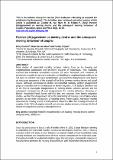Files in this item
Partner (dis)agreement on moving desires and the subsequent moving behaviour of couples
Item metadata
| dc.contributor.author | Coulter, Rory | |
| dc.contributor.author | van Ham, Maarten | |
| dc.contributor.author | Feijten, Peteke | |
| dc.date.accessioned | 2015-04-24T09:31:01Z | |
| dc.date.available | 2015-04-24T09:31:01Z | |
| dc.date.issued | 2012-01 | |
| dc.identifier | 28221109 | |
| dc.identifier | 4a0bf85b-b4e2-4746-99a2-4cf2bf6766ca | |
| dc.identifier | 000298591400002 | |
| dc.identifier | 84155164854 | |
| dc.identifier.citation | Coulter , R , van Ham , M & Feijten , P 2012 , ' Partner (dis)agreement on moving desires and the subsequent moving behaviour of couples ' , Population, Space and Place , vol. 18 , no. 1 , pp. 16-30 . https://doi.org/10.1002/psp.700 | en |
| dc.identifier.issn | 1544-8444 | |
| dc.identifier.other | ORCID: /0000-0002-2106-0702/work/64697488 | |
| dc.identifier.uri | https://hdl.handle.net/10023/6568 | |
| dc.description.abstract | Most studies of residential mobility decision-making focus on the housing and neighbourhood satisfaction and pre-move thoughts of individuals. This implicitly assumes that individual evaluations represent the wider household unit. However, if partners in a couple do not share evaluations of dwelling or neighbourhood quality or do not agree on whether moving is (un)desirable, ignoring these disagreements will lead to an inaccurate assessment of the strength of the links between moving desires and actual moves. Although overlooked in studies of residential mobility, partner disagreement plays an important role in the literature on family migration. This study is, therefore, one of the first to investigate disagreements in moving desires between partners and the subsequent consequences of such disagreements for moving behaviour. Drawing on British Household Panel Survey data and concepts from family migration studies, we find that disagreement about the desirability of moving is most likely where partners do not share perceptions of housing stress. Panel logistic regression models show that the moving desires of both partners interact to affect the moving behaviour of couples. Only 7.6% of couples move if only the man desires to move, whereas 20.1% of shared moving desires lead to a subsequent move. | |
| dc.format.extent | 15 | |
| dc.format.extent | 376471 | |
| dc.language.iso | eng | |
| dc.relation.ispartof | Population, Space and Place | en |
| dc.subject | Residential mobility | en |
| dc.subject | Household decision-making | en |
| dc.subject | Moving desires | en |
| dc.subject | Partner disagreements | en |
| dc.subject | Satisfaction | en |
| dc.subject | GF Human ecology. Anthropogeography | en |
| dc.subject.lcc | GF | en |
| dc.title | Partner (dis)agreement on moving desires and the subsequent moving behaviour of couples | en |
| dc.type | Journal article | en |
| dc.contributor.institution | University of St Andrews. Geography & Sustainable Development | en |
| dc.contributor.institution | University of St Andrews. School of Geography and Geosciences | en |
| dc.identifier.doi | 10.1002/psp.700 | |
| dc.description.status | Peer reviewed | en |
This item appears in the following Collection(s)
Items in the St Andrews Research Repository are protected by copyright, with all rights reserved, unless otherwise indicated.

